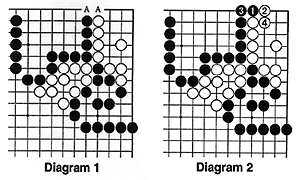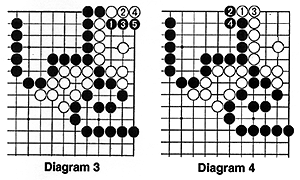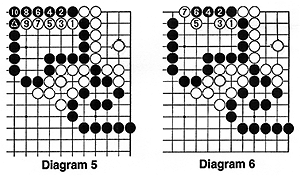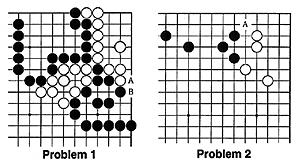The 11th TV Asia Cup
In each of the three main go-playing countries, China, Japan and South Korea, a go tournament is sponsored by the state-run TV station. These weekly tournaments are broadcast nationwide and are avidly followed by go fans in those countries. The winner and runnerup of each national tournament are given a place in the TV Asia Cup. In addition, the winner of the previous year's cup is seeded in the tournament.
The main feature of the Asia Cup, like all TV tournaments, is that it is a speed tournament: each player is given 10 minutes free thinking time, but after that he must make each of his moves within 30 seconds. Therefore, this tournament can be billed as the World Lightning Go Championship.
This year interest focused on Norimoto Yoda, winner of the NHK Cup for the last two years and winner of last year's Asia Cup (Yoda also won this cup in 1993). Over the years, Japan has faired badly in international tournaments with most of its top players losing to the strong young prodigies emerging in China and South Korea. However, Yoda is one of the few Japanese professionals with an excellent record against these players.
Yoda's first opponent was Chang Hao, China's 22-year-old No. 1 player and winner of CCTV Cup. Chang is a consistent player who rarely loses, but Yoda was too strong for him and convincingly defeated him. The game was broadcast on May 26.
The next day, Yoda had to face the formidable Lee Chang Ho, the winner of the South Korean KBS Cup, in the final. As he usually does, Lee rolled over his opponents in the first two rounds living up to his nickname, "The Tank with a Broken Brake" and setting the stage for a final showdown between Japan and South Korea. Yoda has been one of the few Japanese players to have consistently beaten Lee (six wins to one loss). But last April 20 in the Chunlan Cup quarterfinals, Lee beat Yoda by half a point, so there was a feeling that Lee might have finally gotten Yoda's number. But in a hard-fought game, Yoda managed to eke out a 2½-point win. There was a moment, however, when it looked like Yoda might have blown the game. He apparently made a slip in the endgame and suddenly started castigating himself in a loud and angry voice, "I'm an idiot."
Lee, whose endgame is usually flawless, made a number of slips himself, so in the end Yoda's 2½-point victory was what had been predicted after the middle-game contest had ended.
Japanese players have failed to win any major international tournaments in the last two years, so Yoda's victory was a badly needed boost for the morale of Japanese go fans.
1st Chunlan Cup
With South Korean companies sponsoring three big international tournaments and Japan having one of its own (Fujitsu Cup), China has also thrown its hat in the ring and established a major international tournament with a first prize of $150,000. After four rounds in which players from China, Japan, South Korea, Taiwan, Europe and the United States competed, the final became a contest between two South Koreans: Lee Chang Ho and Cho Hoon Hyun. After winning all the other international tournaments over the last year, everyone expected Lee to beat his compatriot and teacher in the best-of-three final. But Cho, who is certainly one of the top players in the world, beat Lee 2-1. This put a stop to Lee's run of four consecutive international titles.
12th Fujitsu Cup
After having had such a successful season over the last year, everyone expected Fujitsu Cup champion Lee Chang Ho to do much better than he did in this year's Fujitsu Cup. However, in his first game he faced Masao Kato, one of Japan's top players who has won more than 40 titles in his career. The game was close, and it seemed as if it would be decided in the endgame, where Lee is particularly strong, but Kato played a brilliant maneuver in the middle game and Lee was forced to resign. Kato lost to Ma Xiaochun of China in the next round and Japan's number one Cho Chikun lost to Yoo Chang Hyuk. Yoo is one of South Korea's top players and was Fujitsu Cup champion in 1993. Ma has also won this cup; his victory came in 1995. The final game of this tournament will be played on Aug. 7.
Endgame calculations
The endgame game usually begins when both sides have mapped out and secured their respective territories. Each side then tries to expand his own territory and decrease his opponent's as much as possible. Here is a simple example.

In the position in Diagram 1, White has secured territory in the upper right corner, while Black has secured territory at the top. However, the border between these two territories around the points A are not yet defined, and whoever plays here first can gain some points.
For example, if Black plays 1 in Diagram 2, White must defend at 2. Black then connects at 3 and White defends with 4. By playing these moves, Black has deprived White of the points 2 and 4 as his territory.
White 4 in Diagram 2 is an important defensive move. If White omits it, Black will atari with 1 in Diagram 3. White might resist with 2, but Black will drive White into the corner point and capture three White stones with 5. White has suffered a huge loss.

If it is White's turn to play, he will play 1 in Diagram 4. Black will block at 2. After White connects with 3, Black connects at 4. In this case, White has deprived Black of the two points 2 and 4. Compare Diagrams 2 and 4.
In Diagram 2, White's territory is two points less than in Diagram 4, while Black's territory in Diagram 4 is two points less than in Diagram 2. From this we can conclude that Black 1 in Diagram 2 or White 1 in Diagram 4 is worth four points.

Again Black must connect at 4 in Diagram 4. It might appear that Black can link up to the marked stone with the sequence to Black 10 in Diagram 5. However, White will not play this way. Instead, he will first atari with 3 in Diagram 6, then, after Black 4, play a net tesuji with 5. After White 7, there is no escape for the black stones.

Here are two positions for you to think about? In Problem 1,how many points are Black A or White B worth. In Problem 2, how many points is Black A or White A worth? The answers will appear next week.
